
Nudibranchs are a group of soft-bodied, marine gastropod molluscs which shed their shells after their larval stage. They are noted for their often extraordinary colours and striking forms, and they have been given colourful nicknames to match, such as "clown," "marigold," "splendid," "dancer," "dragon," or "sea rabbit." Currently, about 3,000 valid species of nudibranchs are known.

Sea slug is a common name for some marine invertebrates with varying levels of resemblance to terrestrial slugs. Most creatures known as sea slugs are actually gastropods, i.e. they are sea snails that over evolutionary time have either completely lost their shells, or have seemingly lost their shells due to having a greatly reduced or internal shell. The name "sea slug" is most often applied to nudibranchs, as well as to a paraphyletic set of other marine gastropods without obvious shells.
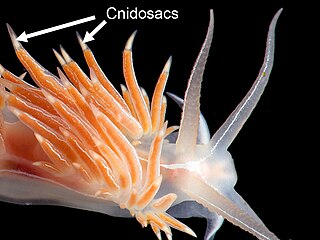
Ceras, plural Cerata, are anatomical structures found externally in nudibranch sea slugs, especially in aeolid nudibranchs, marine opisthobranch gastropod mollusks in the clade Aeolidida. The singular of cerata is ceras, which comes from the Greek word "κέρας", meaning "horn", a reference to the shape of these structures.
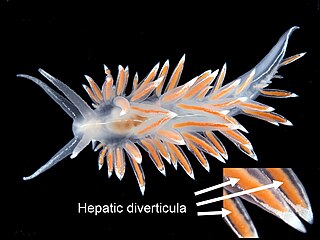
As applied to mollusks, the New Latin term diverticulum is an anatomical feature. The term is most often encountered in the plural form as "diverticula", "hepatic diverticula", or "digestive diverticula", which are anatomical terms for organs which are visible from the outside of the body in a clade of sea slugs known as aeolid nudibranchs, marine opisthobranch gastropod molluscs.

Fiona pinnata, common name Fiona, is a species of small pelagic nudibranch, a marine gastropod mollusk in the superfamily Fionoidea. This nudibranch species lives worldwide on floating objects on seas, and feeds mainly on barnacles, specifically goose barnacles in the genus Lepas.
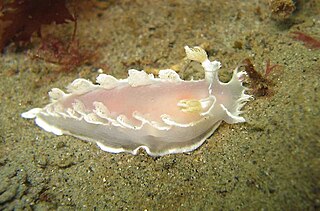
The Tritoniidae are a taxonomic family of dendronotid nudibranchs, shell-less marine gastropod molluscs. These nudibranchs occur worldwide in warm and temperate seas. The genera in the family Tritoniidae include:

The white-edged nudibranch, Fjordia capensis, is a species of sea slug, specifically an aeolid nudibranch, a very colourful sea slug. It is a marine gastropod mollusc in the family Flabellinidae.

Trinchesia speciosa, common name the "candy nudibranch", is a species of sea slug, an aeolid nudibranch, a marine gastropod mollusc in the family Trinchesiidae.

Pteraeolidia ianthina is a sea slug, an aeolid nudibranch in the family Facelinidae. It is known as a blue dragon, a name it shares with Glaucus atlanticus.
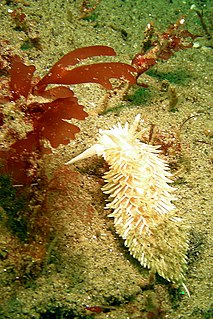
Ziminella salmonacea, common name the salmon aeolis, is a species of sea slug, an aeolid nudibranch, a marine gastropod mollusc in the family Paracoryphellidae.
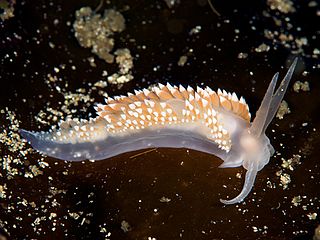
Coryphella verrucosa, is a species of sea slug, an aeolid nudibranch, a marine gastropod mollusc in the family Flabellinidae. It is found on either side of the northern part of the Atlantic Ocean.

Janolus cristatus, sometimes known by the common name crested aeolis, is a species of nudibranch, a marine gastropod mollusc in the family Proctonotidae.

Okenia aspersa is a species of sea slug, a Dorid nudibranch, a marine gastropod mollusc in the family Goniodorididae.

A cnidosac is an anatomical feature that is found in the group of sea slugs known as aeolid nudibranchs, a clade of marine opisthobranch gastropod molluscs. A cnidosac contains cnidocytes, stinging cells that are also known as cnidoblasts or nematocysts. These stinging cells are not made by the nudibranch, but by the species that it feeds upon. However, once the nudibranch is armed with these stinging cells, they are used in its own defense.
Anteaeolidiella lurana, is a species of sea slug, an aeolid nudibranch. It is a marine gastropod mollusc in the family Aeolidiidae.

Tenellia phoenix is a species of sea slug, an aeolid nudibranch, a marine gastropod mollusc in the family Fionidae.

Trinchesia caerulea is a species of sea slug, an aeolid nudibranch, a marine gastropod mollusc in the family Trinchesiidae.
Dendronotus elegans is a species of sea slug, a dendronotid nudibranch, a shell-less marine gastropod mollusc in the family Dendronotidae.
Cumanotus fernaldi is a species of sea slug, an aeolid nudibranch, a marine gastropod mollusc in the family Cumanotidae.
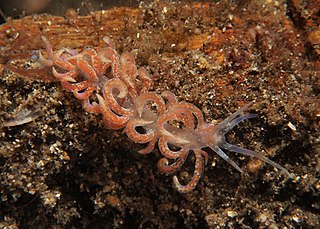
Phyllodesmium poindimiei is an Alcyonacea feeding, aeolid nudibranch Gastropod belonging to the family Facelinidae. Cerata are important in this clade in terms of their physical defense and efficient metabolic processes.This species is spread sporadically along tropical coastal regions such as Australia, Hawaii, and the Indo-Pacific living in diverse marine habitats such as coral reefs. Unlike other species in the Opisthobranch Mollusca clade, P. poindimiei’s lush pink cerata are used for defensive purposes other than Nematocyst (dinoflagellate) capture and toxin release. Organismal ties within these thriving, tropical ecosystems can be determinants of environment change, which affects massive coral ecosystems. Continuously changing marine ecosystems, such as coral reefs, are directly linked to the evolution of organisms that live and thrive in the tropics such as the soft nudibrach P. poindimiei.
















